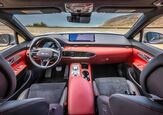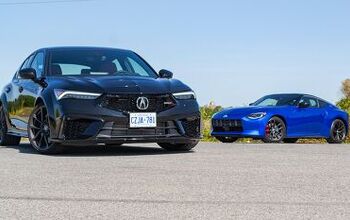Mazda3 Vs Mazda6 Comparison

Despite what the Detroit-based automakers will tell you, there remains a market for small and mid-sized cars.
While the likes of the Focus, Impala, and Dart have been given a one-way ticket to death’s nursery, companies like Mazda continue to refine their offerings in the segment, resulting in some of the best three-box family whips ever to come out of Hiroshima.
Get a Quote on a New Mazda3 or Mazda6Like so many other brands, Mazda deploys an alphanumeric system with which to label their machines. Here, at least, there is some semblance of order. The Mazda3 is smaller in size than the 6, plain and simple. The little brother does have a pair of body styles, sedan and hatch, whereas big bro is a sedan-only affair.
Powertrains
Mazda3: Apart from the regular 2.5-liter four-pot making 186 hp and 186 lb-ft of torque that’s also available in the 6, 2021 onwards, the 3 gets the 2.5-liter turbo as well. Yep, a smaller package with a bigger engine from its bigger sibling. Just like the 6, here too it makes 250 hp and 320 lb-ft of torque if fed with 93 octane fuel. With regular fuel, the power drops to 227 hp but the torque only drops by 10 lb-ft, which leaves plenty of zip for the little hatch. There is a six-speed manual on offer but it is available on the Premium trim of the hatchback only. While all other trims including every sedan trim and turbo powertrains come with the six-speed automatic only.
Speaking of the sedan, it comes with an exclusive 2.0-liter four-pot making 155 hp and 150 lb-ft of torque. Hooked up to a six-speed automatic (as we mentioned before), it drives the front wheels and is only available with the base S trim.
Mazda6: A choice of two powertrains face buyers of the 6 sedan. Both displace 2.5L but one is turbocharged. The non-boosted mill makes 187 horsepower and 186lb.-ft of torque (sound familiar?) and is paired with a six-speed automatic. Adding a turbocharger to this engine bumps output to 227 horses – or 250hp when fed a steady diet of 93-octane fuel – and a heady 310lb.-ft of twist. This engine also plays well with a six-speed automatic but, thanks to the turbo’s different style of power delivery, features different gear ratios.
SEE ALSO: 2018 Mazda6 Review
Bottom Line: Having driven all variations of these powertrains, your author deeply enjoys the wave of torque found in the turbocharged Mazda 6. The six-speed manual in the 3 is great fun, allowing drivers to row their way through a fun back road, but it is only available on high-zoot trims.
Fuel Economy
Mazda3: Front-drive versions equipped with the naturally aspirated engine and automatic transmission earn a fuel economy rating (mpg) of 26 / 35 / 30 on the city, highway, and combined cycles respectively. Oddly, the stickshift (hatchback only) exacts a 1mpg penalty across the board except in highway driving. Selecting all-wheel drive scuppers economy by a slight margin, forcing the company to advertise numbers of 25 / 33 / 28 for the sedan and 24 / 32 / 27 for the hatchback. Moving to the turbo powertrain, only available with AWD, returns 23 mpg in the city and 32 mpg out on the highway in the sedan while the hatch returns 23 mpg in the city, 31 mpg on the highway and both manage an overall efficiency of 27 mpg.
Mazda6: Speed costs money; how fast do you want to go? Non-turbo 6 sedans predictably get better fuel economy than their hi-po brothers. Mazda ranks the naturally-aspirated 2.5L engine at 26 / 35 / 29 and the turbo mill at 23 / 31 / 26 (mpg, city / hwy / combined).
Bottom Line: It is a remarkable achievement that the much larger 6 gets essentially the same economy numbers as the 3 sedan and hatch. The bigger car costs more upfront, of course, but running costs – at least in terms of fuel – will be roughly equal.
Cabin Space
Mazda3: In terms of room for people, the hatchback and sedan variants of the 3 are within a hair’s breadth of each other in all dimensions. Front and rear headroom are listed at 38 and 37.3 inches, respectively, with opting for a moonroof shaving 0.4 inches from each measure. Legroom is a surprising 42.3 inches up front and 35.1 inches for backseat urchins. Passenger volume works out to 92.8 cubic feet.
Mazda6: The larger sedan offers just a smidgen more headroom than the 3 but robs it back when a sunroof is fitted. Front legroom is markedly similar to the 3, at 42.2 inches, but rear-seat space is much more vast, clocking in at 38.7 inches. Total passenger volume is 99.8 cubic feet. There is also three more inches of hip room in the backseat compared to its smaller showroom mate, meaning it’ll be easier to fit three abreast or a pair of car seat for little kiddos.
Bottom Line: If your family includes any budding NBA stars, be sure to sample the 6 sedan.
Cargo Capacity
Mazda3: It will surprise no one that the hatchback version of this car aces the cargo test, offering a voluminous 20.1 cubic feet of space behind its rear seats. Selecting the sedan chops that available room to just 13.2 cubes, meaning those who pursue an active lifestyle but don’t want a me-too crossover would be wise to check out the 3 hatchback.
Mazda6: Total cargo volume of this car is 14.7 cubic feet. As a traditionally-shaped sedan, its trunk can accept gear that is wide but not very tall. Suitcases and carry-ons are no problem but cube-shaped boxes will be a challenge. The rear seats do fold down to accommodate long items.
Bottom Line: Sedans gonna sedan, meaning their basic shape precludes them from shuttling as much stuff as a hatchback. Despite being eight inches shorter than the 3 sedan and a vast seventeen inches shorter than the 6 sedan, the 3 hatchback out-carries them all.
Technology
Mazda3: The hatchback and Select trim of sedan include the same raft of safety tech described below for its bigger brother. A 12-speaker BOSE audio system is available and 8-speakers come as standard. A snazzy 8.8-inch center display looks expensive and expansive. A 7-inch reconfigurable TFT gauge cluster display allows drivers to act out their Top Gun fantasies.
While safety tech like radar cruise control and lane-keeping assist are available as standard. Necessary features like blind spot monitoring with rear cross traffic alert are available Select trim onwards. If you want smart brake support along with the blind spot monitoring, it is only available on the Turbo Premium Plus trim only.
Mazda6: A standard suite of safety tech means the 6 is equipped with many features once reserved for high-dollar machines. Radar cruise control with stop and go function help to soothe frazzled nerves on the daily commute, while lane departure warning and lane-keeping assist help drivers to color inside the lines. CarPlay and Android Auto (finally) inhabit the infotainment system.
Bottom Line: Mazda’s engineers are focused on driving, so it shouldn’t be a surprise that the infotainment systems dissuade the use of a touchscreen. This is a good approach for encouraging drivers to keep their eyes on the road and their hands upon the wheel.
Style
Mazda3: The new 3 just oozes cubic acres of style. To say it looks like a modern day Alfa Romeo Brera is a fair assessment and high praise. Buying a small car used to mean eating off the dollar menu but today’s small Mazda sedans and hatchbacks would look at home in any driveway or condo parking garage. Stylists gave the hatchback version a rump to rival Nicki Minaj and a set of taillights that look like afterburners. Don’t listen to those who claim its d-pillar scuppers blind-spot viewing – that’s what the warning system before. Hey, style demands sacrifices.
Mazda6: In a world where even the staid Toyota Camry has been fettled to look like a stormtrooper’s helmet, the 6 sedan has a remarkably fluid and graceful shape. Flared and curved sheetmetal above the front wheels recall the MX-5 convertible and – dare we say it – the lamented RX-8 coupe. An elegant set of peepers booked a grille that’s bordering on just a bit too large.
Bottom Line: All of the machines in this comparison are attractive but the 3 hatchback, especially in Soul Red Crystal Metallic, is the best-looking vehicle of this bunch. Conversation over.
Pricing
Mazda3: For 2021, the base Mazda3 sedan with the 2.0-liter motor starts at $21,645 (including destination). Popping for all-wheel drive necessitates stepping up to the second-tier Select model which adds $3,600. Like for like, AWD adds $1400 to the Select trim itself. Hatchback buyers will shell out at least $23,645 (including destination) for an entry-level front-drive automatic-equipped model; sending power to all four wheels is a $1400 proposition here as well. If you want that stick shift, it’ll cost a heady $28,995 and is only available with the FWD version of the Premium trim.
Mazda6: Priced at just $25,470 (including destination), the Mazda 6 offers a lot of family space for the money. At this sum, one will find themselves in a Sport trim featuring all manner of LED exterior illumination and zoomy dual exhaust outlets. Inside are a leather-wrapped steering wheel and a push-button start system. The turbocharged engine first shows up on $31,170 Grand Touring models.
Bottom Line: It’s hard to argue with the 6 Sport’s value proposition, especially given its attractive and spacious interior. Style-conscious gearheads will have no doubt noted the cheapest version of the striking 3 hatch is priced $1,800 below the entry-level 6 sedan. Style or space? It’s your choice.
Mazda3 vs Mazda6: The Verdict
Despite their sales numbers taking a southern turn, it’s tough to go wrong with either of these beautifully styled cars. There’s a lot to like in both machines, from their exterior styling to a cabin that looks a lot more expensive than it really is. Outwardly, there’s little to distinguish their individual trims (thanks, economies of scale!) so it’s unlikely your nosy neighbors will be able to tell from a distance if you bought a base or fully-loaded model.
Mazda3, Mazda6
LOVE IT
- Great interior
- Fun to Drive
- All-wheel drive
- Fantastic steering
- Sexy styling
- Overall refinement
LEAVE IT
- Poor outward visibility
- Pricey for a compact
- Plastic accent on front seats
- Real wood trim looks cheap
- Dated infotainment

Living in rural Canada, Matthew has immersed himself in car culture for over 30 years and relishes the thought of a good road trip. A certified gearhead, he enjoys sharing his excitement about cars and is very pleased to contribute at AutoGuide. Matthew is a member of Automotive Journalists Association of Canada (AJAC).
More by Matthew Guy













































Comments
Join the conversation